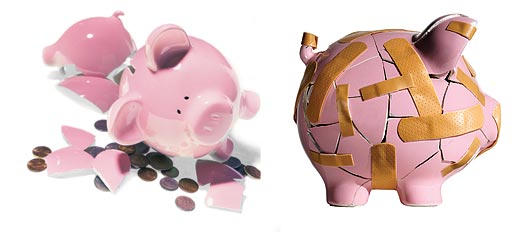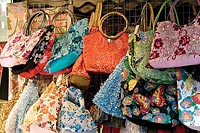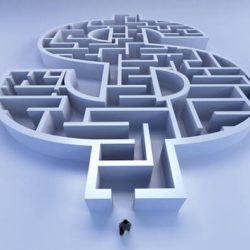Consumer Wake-Up Call
During tough economic times, people are learning money lessons the hard way. But will these new habits disappear when things start looking up?
As the nation’s financial markets collapsed in September 2008, causing consumer wallets across the country to snap shut, Mara Opperman ’02 started selling diamonds.
A year and a half before, Opperman and her brother, Josh, had co-founded a Web site that allows people who have fallen in and out of love to buy and sell used engagement rings — charging buyers less than they’d pay for a new ring and paying sellers more than they’d make returning a ring to a jewelry store. During summer 2008, business essentially had been flat at their site, I Do Now I Don’t. But when the markets did their version of a cannonball dive, visits to the site shot up. In October 2008 alone, traffic nearly tripled compared to the previous month, and sales rose by 68 percent.
“Really, we attribute it to what’s going on in the economy, because we feel that buyers are looking for great deals,” Opperman says. “At the same time, sellers are looking to make money, so we have a nice partnership between the buyers and sellers [during this downturn].”
In the midst of economic disaster, UW-Madison researchers see one bright spot: by necessity, consumers are learning to be better stewards of their money. They’re identifying the things that they don’t need and finding ways to save money on the things that they do. Faculty studying topics such as mortgages and retail stores see those changes as likely to last for years, if only because people now have fewer chances to revert to their old ways.
The recession has also confirmed an important insight into markets that some UW-Madison researchers first had years ago — that irrational, even self-defeating, choices by everyone from laid-off workers to wealthy bankers can undermine a neighborhood and, eventually, an economy.
A Sign of Things to Come
Years before the housing and lending crisis upended lives around the country, J. Michael Collins watched the leading edge of the economic downturn slice through the southwest side of Chicago. Though he didn’t know it then, the consumer researcher was getting an early view of the flood of bad debt and disastrous decisions that in time would flow out of poor, black, and Latino backstreets and into well-off, white side streets in suburbs around the United States.
Now an assistant professor of consumer science at UW-Madison’s School of Human Ecology, Collins was then a policy researcher for NeighborWorks America, a nonprofit created by Congress to promote home ownership and financial independence among the working poor. He went to Chicago to study families in areas such as Back of the Yards, a tough neighborhood that a century ago served as the setting for Upton Sinclair’s muckraking novel about poor immigrant meatpackers, The Jungle. In 2001 and 2002, the minority neighborhood was facing a resurgence of hard times, with as many as one in four homes in some stage of foreclosure.
Some of these struggles were even spreading to the city’s better-off neighborhoods that were home to middle-class African-Americans. This troubling mini-trend in parts of the Windy City was also showing up in a few other communities such as Detroit and Atlanta, but it still wasn’t getting much national attention. As in Chicago, poor and working-class minorities dominated these areas. Collins went to investigate what was going wrong in these places, hoping to stop the trend from undoing the work that his group and so many others had done during the prosperous 1990s to help move low-income families into home ownership.
What Collins discovered defied the traditional laws of economics, in which rational actors seek the greatest benefits available to them and avoid the greatest losses. In focus groups and surveys, Collins talked to low-income homeowners — strapped for cash and driven by their desires and fears — who were voluntarily giving up loans with fantastic terms that they had obtained with help from the government and nonprofits like his. Behind on payments on shorter-term debt such as credit cards, the consumers were grabbing at mortgage refinancing as a quick fix and wrapping that debt into their home loan to get temporarily caught up again. But to do it, the homeowners had to trade in their better-than-market-rate loans for worse-than-market-rate subprime loans, financial deathtraps with annual interest rates as high as 17.99 percent.
“There were people who did up to five or six refinances,” he recalls. “Every year, they were refinancing their loan and rolling more and more debt into it, and their interest rates were going up and up. They were rolling them over because they were late making payments on something else, [such as] credit cards or cars.”
Home values in Back of the Yards didn’t shoot up as quickly in those years as houses in some other parts of the country. But they did rise, and families in the neighborhood — like many other Americans — began to see their houses as piggybanks. One African-American tradesman nearing retirement age had refinanced his mortgage through a broker he knew from church, giving up a government-backed loan with better terms.
“He was sort of suspicious about taking money out of his house, but he wanted a new truck,” Collins says. “His wife said, ‘You’ve worked for a long time; you ought to have a new truck,’ and he got the truck. ‘Now,’ he said, ‘I’m going to lose the truck, and I’m going to lose my house.’ ”
Puzzling Behavior
What was most disturbing and perplexing was what some consumers did after they got into trouble.
Classical economics predicts that homeowners would work with lenders to try to avoid foreclosure, and that they would simply walk away from a mortgage if falling prices meant they suddenly owed more than their home was worth. However, Collins found that many homeowners, attached to their houses, kept paying on these mortgages — even when it didn’t make financial sense. Other homeowners at risk of foreclosure shut down psychologically; they didn’t seek help from the various aid programs available to them, they didn’t respond to phone calls and letters from their banks, and they didn’t investigate whether they could cut a deal with their lenders and avoid foreclosure.
One of these homeowners, Collins recalls, was a flight attendant who got behind on her mortgage payments after she was furloughed from her job following 9/11.
“She didn’t leave her house or read her mail or answer the phone. She was so depressed and so worried and anxious. She was just in tears. … She lost the house. Her credit was ruined,” Collins says. He and his team tried to help the woman get mental health services.
Thinking back to his surveys in Chicago, Collins isn’t surprised that in 2008, as many as half of American borrowers in foreclosure had no contact with their lenders. His fieldwork taught him that people don’t always pursue common-sense actions that are in their own interests. Regrettably, that insight about the potentially destructive role of emotion among homeowners turned out to apply even to sophisticated executives at banks and investment houses. In 2006 and 2007, as the housing market began to slow, lenders eager for a quick profit handled a baffling boom in subprime mortgage loans that intensified the inevitable crash that followed.
“We had a problem that was going to be a major problem, and it became a catastrophe,” Collins says.
During those years, Collins was working on his PhD in policy analysis at Cornell University, where he studied both economics and psychology, including the extensive literature that has examined how emotions influence decision-making. Today, through efforts such as UW-Madison’s Center for Financial Security, he uses that broader perspective in research that seeks to inform public-policymakers on ways to help families use, save, and invest their money wisely.
Collins and others in the field are now finding a more receptive public among both decision-makers and ordinary Americans — by necessity. When the economic crash came in September 2008, people like Jonathan Rehm started behaving differently. They didn’t have a choice.
Want Versus Need
A twenty-seven-year-old heating, ventilation, and air conditioning technician in Vancouver, Washington, Rehm recently had to sell a $3,000 diamond engagement ring that he had bought for his fiancée. The trouble started when an equipment purchase for a side business — putting on laser light shows — left him more in the red than he’d hoped. Then, because of the poor economy, he started picking up fewer hours at work. In November 2008, Rehm and his fiancée called off their engagement, although they stayed together. The following February, he sold the engagement ring to a Massachusetts buyer through I Do Now I Don’t for $1,900. He recouped a little more than 60 percent of the price he’d originally paid, about average for sellers who use the Web site.
“Everybody’s cutting a few more corners these days,” he says.
For consumers like Rehm, cutting corners can also mean deferring dreams. Yet not all of the news is bad. After several years during which consumers saved practically nothing — including a brief period in 2005 when they even spent more than they were taking in — in spring 2008, they increased what they were saving. During the first three months of 2009, consumers saved 4.4 percent of their disposable income, well below the roughly 10 percent savings levels in the early 1980s, but still the highest rate in a decade.
“I think there really will be a move toward a little more frugal attitude everywhere,” says retail expert Jerry O’Brien. “People are redefining want versus need.”
O’Brien spent twenty-seven years working for the retailer Target, the last eleven of them managing a store on Madison’s West Side, before leaving to become the director of the Kohl’s Department Stores Center for Retailing Excellence at UW-Madison. After the economic meltdown, O’Brien noticed that people suddenly stopped spending money on faster computers or high-definition plasma televisions.
“We’ve been in a trend for a long time where people were willing to upgrade [their electronics],” O’Brien says. “The first real visible thing I saw is people stopped upgrading. They said, ‘I’ve got a TV.’ ”
In addition, shoppers in grocery stores began switching from premium food brands to the cheaper, in-store varieties. Retailers such as Wal-Mart — known for low prices and essential goods like food — performed well, while their slightly more upscale competitors stumbled, according to both O’Brien and Cynthia Jasper MS’82, PhD’84, a professor of consumer science at UW-Madison.
“What I find interesting is that the majority of consumers are changing their habits at this point, and they are becoming more price-focused and cutting back on some of their excesses,” Jasper says.
The pullback by consumers following the crash was so pronounced that it strained that most-American of retail relationships: our love affair with malls. Shopping centers saw a double-digit drop in business in October 2008, Jasper says. Shoppers’ sudden reluctance to spend had a lot to do with the deteriorating labor, housing, and stock markets, all of which left consumers with less income and accumulated wealth to spend. But the economic turmoil in communities across the country also affected many consumers who hadn’t lost their jobs or seen their homes drop precipitously in value. These consumers hadn’t lost their ability to spend — just their desire to do so — during what they then perceived as a risky financial time.
“We all see friends, neighbors, and relatives losing their jobs,” Jasper says. “There’s a psychological factor.”
In the midst of that uncertainty, consumers are re-evaluating what’s important, O’Brien says. Some are cutting out a portion of spending altogether, while others are finding cheaper substitutes or putting more emphasis on other aspects of products, such as whether they’re environmentally friendly or locally made.
“What I think consumers are doing is redefining what value means to them individually,” O’Brien says.
Getting Even
Mara Opperman thinks I Do Now I Don’t is poised to take advantage of many of those trends. The business started with a very personal bit of re-evaluation.
Opperman’s brother, Josh, had spent his savings to buy his fiancée an engagement ring costing more than $10,000. Three months later, he returned from a weekend away to find that his fiancée had broken off the engagement and cleared her things out of their New York City apartment, leaving only the ring behind. When he took the ring back to the jeweler, Opperman got another shock: how little the retailer was willing to pay him for it. That gave Josh the idea for an elegant revenge — a site where the jilted could sell their jewels, and where their hard-luck stories could become marketing hooks. Launched in January 2007 as a moonlighting project for the brother-sister pair, the Web site had early success. Mara successfully brought the site to the attention of major media, including CNN and the Rachael Ray Show, and, eventually, the pair quit their day jobs.
But it was the economic downturn that took the site to the next level. As traffic surged in late 2008, Mara Opperman noticed a change in the stories that sellers were posting to explain why they were trying to sell their rings.
“When the spike happened, we started seeing more stories about people needing the money to finance things,” she says.
Staying Power?
More consumers may be wising up and becoming thriftier, but are their new habits likely to last when the economy turns around? Although Jasper is among those who suspect that consumers may happily return to their wasteful ways if they get the chance, she says, “I think it depends on exactly how this recession resolves itself — when and how.”
Economist Menzie Chinn of the UW’s La Follette School of Public Affairs questions whether consumers will have the means to go back to big spending. After all, their houses, retirement savings, and other investments have suffered a “wealth shock” that has wiped out some $13.9 trillion in assets since June 2007, leaving them with less money to spend today and more need to save for tomorrow, he says. Home mortgages, lines of credit, and even credit cards — that final refuge of American consumers — are becoming more difficult to overuse as banks tighten their standards.
Collins also sees some reasons to be hopeful based on a survey of renters that he conducted in Chicago and San Francisco in fall 2008. When asked how many homebuyers end up in foreclosure, these renters estimated about one in every three, indicating that these potential homebuyers clearly understood the risks of buying a house and, in fact, overestimated them. (Even borrowers with subprime mortgages default at cumulative rates of around 20 percent, Collins says.) Most of the renters weren’t interested in buying a home at the time of Collins’ survey, but a majority said they’d likely buy a home within three years and welcomed information about how to make the purchase, wanting to become educated consumers before taking such a big step.
“I think people are learning some hard lessons,” Collins says.
Jason Stein MA’03, a Madison freelance writer, Wisconsin State Journal reporter, and homeowner, is thankful that he has never had reason to sell an engagement ring.
Published in the Winter 2009 issue





Comments
No comments posted yet.